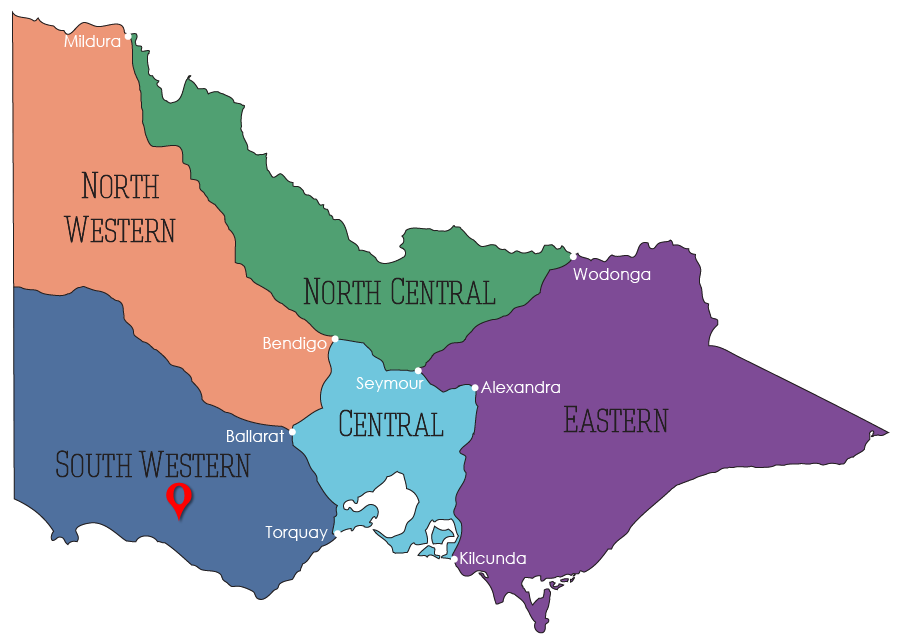 On the 27th Of October, 1841, two Aborigines were reported to have been beaten and then shot at Leighton Station, on the Hopkins River, located in the south-western region of Victoria . . .
On the 27th Of October, 1841, two Aborigines were reported to have been beaten and then shot at Leighton Station, on the Hopkins River, located in the south-western region of Victoria . . .
The following extract reflects the attitude of the settlers at the time:
” . . . On the 27th Of October, 1841, Tachier/Tatcher/Tatkier, a Gunawurd gundidj, and his wife, Terang-gerang ere, and a boy named Bang it bang, were crossing GS Bolden’s Leighton Station, on the Hopkins River, on their way to Sievwright’s Protectorate station at Lake Terang (a distance of approximately 11 miles). Bolden and his men, who were mustering cattle, took to them with whips and when Tatkier tried to pull Bolden from his horse, the squatter shot him in the stomach. Tatkier took refuge in a nearby waterhole, but was later killed when Bolden fired at him a second time. Terang-gerang-ere was so badly beaten around the head by William Kiernan (or Kerney), a stockkeeper, that she also died. The following day several Gunawurd Aborigines, along with the boy, who had managed to escape, arrived at Sievwright’s encampment where Bang it bang related what had happened. Sievwright managed to get Bolden to court in December, 1841, on a charge of shooting with intent to kill Tatkier. Kiernan in giving evidence at the trial stated ‘I do not know the native’s name, the same man I found killing a beast on the nineteenth of the month. I saw him several times before . . .’. At the trial Sievwright stated ‘I knew Tatcher, I was perfectly acquainted with his person. I have no doubt he is one of the tribe over which I have superintendence . . . this man belonged to the Connawa tribe, about fifteen miles from the place of the collision’. Bang it bang’s evidence was ridiculed in court, and Judge Willis advised the jury to acquit Bolden, enunciating the principle that squatters ‘have a clear and a distinct right to turn any person off their property, that may come on it, for the purpose of aggression or not’. In his notebook entry on this case Willis (RHSV Ms) wrote, ‘. . . there being no reservation in the grant, lease, licence from Government in favour of the Aborigines, the possessor had also a right by all lawful means to turn off any person whether white or black who also trespass on his run . . .’ Squatting licences were issued on the condition that Aborigines had free access to their former hunting places, however the squatters who were convinced that their ten pound licence fee entitled them to exclusive use of their runs would have warmly received Willis’ judgement.
The case went before the Supreme Court in Melbourne in December 1841 and Bolden was acquitted. Two of Bolden’s employees testified at the trial: Peter Carney, employed as a stockman; and William Kiernan, a stock keeper. Judge Willis, charging the jury, said,
I have no hesitation to say that, if a person has a run, for which he pays a license, and a man or any persons come to that run, the owner or lessee has a right to use lawful means to recover any property that may be attempted to be carried away. I care not whether they are white or black — I may turn them off my property. I will go further; if government take upon themselves to assume the ownership of the soils, the lessees have the right to look to them for a sufficient guarantee of their property, and they have a clear and distinct right to turn any person off their property that may come on it for the purpose of aggression or not. (McCombie 1858, 89)
Source: Excerpt – ‘Aboriginal Languages & Clans: An Historical Atlas of Western and Central Victoria, 1800-1900’ – by Ian D. Clark – published 1990
View other important events in this Region’s History . . .
